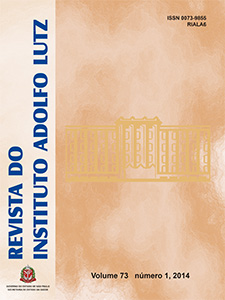Abstract
Five statistical approaches were applied for assessing the performance of participants in 19 rounds (2007-2011) of the Proficiency Testing Program for lead in blood determination (PEP-Pbs), conducted by Instituto Adolfo Lutz. The performance evaluation was provided by using the z-score. The following statistical approaches were tested: 1 – mean and standard deviation, after rejecting outliers; 2 – median and normalized inter-quartile range; 3 – robust mean and robust standard deviation; 4 – robust mean and standard deviation for proficiency assessment of 3 μg/100 mL (for concentrations up to 40 μg/100 mL and a standard deviation for proficiency assessment of 7.5 % of the assigned value (for concentrations above 40 μg/100 mL); 5 – robust mean and standard deviation for proficiency assessment of 2 μg/100 mL (for concentration up to 40 μg/100 mL) or 5 % of the assigned value (for concentrations above 40 μg/100 mL). The approach 4 showed to be the most adequate statistical methodology to assess the performance of participating laboratories in the PEP-Pbs.References
1. Svegl F, Strupi JS, Svegl IG. Proficiency testing of chloride content in different types of Portland cement. Accred Qual Assur.2006;11:414-21.
2. Senyuva HZ, Gilbert J. Assessment of the performance of pesticide-testing laboratories world-wide through proficiency testing. Trends Anal Chem.2006;25:554-62.
3. ISO/IEC 17025. General requirements for the competence of testing and calibration laboratories. 2005.
4. ISO 15189 - Medical laboratories - Requirements for quality and competence. 2012.
5. ISO/IEC 17043. Conformity assessment - General requirements for proficiency testing.2010.
6. Department of Health and Human Services (United States). Preventing lead poisoning in young children 2005. [access 2012 Jul]. Available in [http://www.cdc.gov/nceh/lead/publications/PrevLeadPoisoning.pdf ].
7. Maio FD, Zenebon O, Tiglea P, Okura RIS, Sakuma AM. Evaluation of statistical criteria applicable to interlaboratory comparisons for lead in blood. Rev Inst Adolfo Lutz.2006;65:89-93.
8. Instituto Nacional de Seguridad e Higiene em el Trabajo (Espanha). Programa interlaboratorios de control de calidad (PICC) – plomo en sangre. [access 2012 Jul]. Available in [http://www.insht.es/portal/site/Insht].
9. Yang JS, Lee MY, Park IJ, Moon YH, Kang SK. Korean analytical quality assurance (KAQUA) program for biological monitoring. Int Arch Occup Environ Health.1997;69:361-6.
10. Occupational Safety & Health Administration (United States). [access 2012 Jul]. Available in [http://www.osha.gov/SLTC/bloodlead/protocol.html].
11. Kisets D. Performance indication improvement for a proficiency testing. Accred Qual Assur.2006;10:461-5.
12. Wong SK. A comparison of performance statistics for proficiency testing programmes. Accred Qual Assur. 2007;12:59-66.
13. ISO 13528. Statistical methods for use in proficiency testing by interlaboratory comparisons. 2005.
14. ISO 5725-2. Accuracy (trueness and precision) of measurement methods and results. Part 2 - Basic method for the determination of repeatability and reproducibility of a standard measurement method. 1994.
15. Chui QSH, Barros CB, Silva TD. Parâmetros r e R obtidos de programa interlaboratorial - Como usá-lo. Quím. Nova.2009;32:2209-13.
16. National Association of Testing Authorities (Australia). Guide to NATA Proficiency Testing. [access 2012 Jul].Available in [http://www.dicocare.org/Bibliografia/B_4_Summary_Statistics_NATA_PT_2004_Feb.pdf].
17. ISO 5725-5. Accuracy (trueness and precision) of measurement methods and results. Part 5 - Alternative methods for the determination of the precision of a standard measurement method. 1994.
18. Bio-Rad Laboratories, Inc. (United States). [access 2012 Jul]. Available in[http://www.qcnet.com/Portals/0/PDFs/CLIALimits%283-3-04%29.pdf].
19. Thompson M, Ellison SLR, Wood R. The International Harmonized Protocol for the Proficiency Testing of Analytical Chemistry Laboratories (IUPAC Technical Report).Pure Appl Chem.2006;78:145-96.
20. Royal Society of Chemistry (United Kingdom). Analytical Methods Committee No.6 Robust statistics: a method of coping with outliers. 2001.
21. Willink R. What is robustness in data analysis? Metrologia.2008;45:442-7.
22. Elftheriou P, Papastefanou H. Measuring performance in analytical measurements. Accred Qual Assur.2009;14:67-71.
23. Rosario P, Martínez JL, Silván JM. Comparison of different statistical methods for evaluation of proficiency test data. Accred Qual Assur.2008;13:493-9.
24. Ellison SLR., Barwick VJ, Farrant TJD. Practical statistics for the analytical scientist – A Bench Guide.2th ed. Cambridge (UK):RSC Publishing;2009.
25. Srnková J, Zbíral J. Comparison of different approaches to the statistical evaluation of proficiency tests. Accred Qual Assur.2009;14:467-71.

This work is licensed under a Creative Commons Attribution 4.0 International License.
Copyright (c) 2015 Instituto Adolfo Lutz Journal
